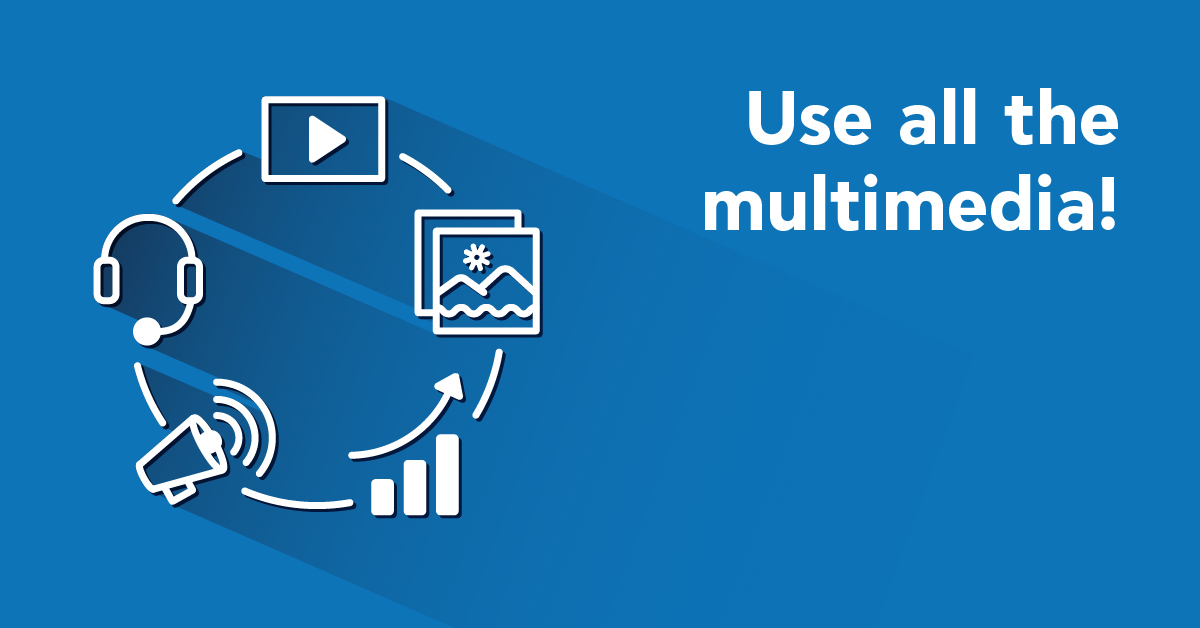Multimedia makes eLearning interactive, entertaining, and easily digestible. But only if you know when, how, and why to use these elements in your eLearning course design. In this article, we’ll highlight 6 factors you should consider when integrating multimedia in eLearning.
6 factors to consider when using multimedia in eLearning
From animations and infographics to interactive presentations, there are a broad range of multimedia options to choose from. However, it’s important to remember that all of these tools serve one key purpose: supporting the subject matter. They should never overshadow the core ideas and concepts, or distract online learners from the learning objectives.
So, how do you add multimedia to your eLearning design without creating chaos and confusion? Here are 6 factors to consider when integrating multimedia in eLearning programs.
1. Multimedia Overload
We’ve all had the misfortune of participating in cluttered eLearning courses. They barraged our brains with more multimedia elements than we could count. At the end all we had to show for it was a headache and memory overload. Sure, the eLearning visuals were impressive and entertaining. But the eLearning course didn’t achieve its primary purpose, which was to enlighten us. Instead, the multimedia got in the way. It became a hurdle instead of a support tool.
This is all supported by scientific fact: our minds are incapable of multitasking. We cannot process two or more forms of media at the same time. Particularly when they are meant to be used in conjunction and can’t stand alone. For instance, a block of text paired with an eLearning video. Online learners are unable to read the text and pay attention to the video simultaneously. To avoid multimedia overload, focus on one element at a time and blend them, if possible. For instance, add subtitles to the eLearning video or a narrated voice-over.
2. Repetitive eLearning Content
Many learning theories support the benefits of repetition. However, this involves repeating the same information in different ways. For example, creating a task-based online tutorial and then exploring every step in an eLearning simulation or scenario. In regard to multimedia, repetition is a double-edged sword. You should reiterate key concepts and ideas to improve knowledge retention.
But the eLearning content should never be redundant. For instance, narrating everything on the screen word-for-word, even though it’s already written in text form.
3. Missed Microlearning Opportunities
One of the benefits of using multimedia in your eLearning course design is simplifying complex ideas. It can also make the information more digestible, which improves learning comprehension and retention. That said, long eLearning videos or presentations have a tendency to overwhelm online learners and cause undue stress. They must find the time to watch the eLearning video without distractions, which is virtually impossible for some, especially in a work context.
On the other hand, microlearning multimedia is quick, convenient, and easily absorbed. Each media element focuses on a specific idea, topic, or task. Thus, online learners are able to complete each eLearning activity, assimilate the eLearning content, and then move onto the next.
Ideally, microlearning should be 5 minutes or less and serve as a complete learning unit. Meaning that it can stand on its own AND support the learning objectives and goals.
4. Choosing Form Over Functionality
It’s true. Aesthetically pleasing eLearning courses boost learner engagement and improve mental focus. However, integrating multimedia simply for the sake of visual appeal is a major faux pas. Multimedia shouldn’t be a filler or superficial fix.
Ultimately, the eLearning content itself is what matters most. You need to convey the key concepts and ideas so that online learners get value from the eLearning experience. Overloading your eLearning course design with irrelevant eLearning images, videos, charts, and audio elements will only distract them.
Before launching your eLearning course, evaluate every multimedia component and ask whether it should be in your eLearning course design. Does it support the learning objectives? Does it serve a function, or are you just using it to enhance the aesthetics?
5. The Power Of Proximity
This is yet another factor that is supported by scientific research. The human mind automatically sees a relationship between objects that are in close proximity. For example, we assume that a graph and a video cover the same topic when they are next to each other. Thus, you should always group multimedia elements based on their subject matter, and distance objects that are not related. The white space in between the media triggers our brains to disconnect them. As such, we will examine each item independently and memorize them as two distinct ideas.
A side note about white space: White space is nothing to be afraid of. In fact, it can help to reduce cognitive overload and improve comprehension. There is no set rule regarding how much white space is too much. So, you’ll have to judge your eLearning course design on a case-by-case basis. It greatly depends on the eLearning course layout, resolution, and consumption device. For instance, a mobile-friendly eLearning course usually has less white space because there is less room to work.
6. Multimedia Mix
The last factor to consider is multimedia variety. It’s always a good idea to integrate a good mix of media elements into your eLearning course design. This gives you the power to cater to different learning preferences. Just make sure that the media components are complementary. As an example, pairing an eLearning audio explanation with an eLearning graph. The eLearning audio clarifies complex trends of statistics that are featured in the eLearning graph.
Research your eLearning audience to determine which multimedia is best and how it can help them achieve their eLearning goals. Surveys, focus groups, and interviews also reveal their mobile learning preferences and tech familiarity. And these considerations have a direct impact on your level of interactivity.
Multimedia gives online learners the power to observe favorable behaviors and put their knowledge into practice. Keep these factors in mind when adding multimedia to your eLearning course to reduce cognitive overload and increase long-term retention.
Are you still searching for the perfect multimedia to integrate into your eLearning course design? Read the article 7 Tips To Choose Multimedia For Your eLearning Course to discover a few helpful tips for choosing multimedia for eLearning experiences.
| Tags: eLearning Design



